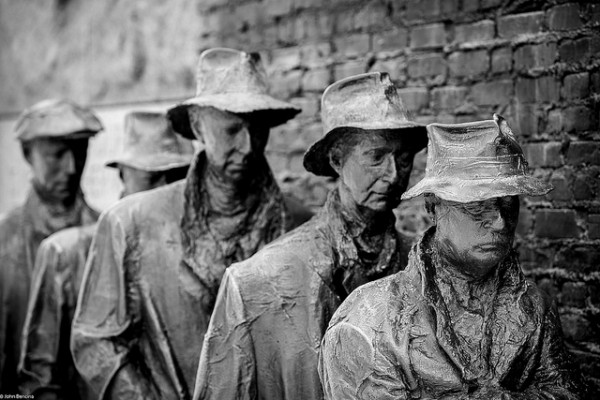
Boom-and-bust cycles are not new. Our economy has had to redefine itself a number of times throughout our history, as Michael Lind’s magisterial book Land of Promise reminds us. And this is not the first time Americans are anxious that there may be no more boom times in their immediate future. In advance of the Zócalo event “Can Old Government Catch up to the New Economy?” featuring Lind, we asked other economic history scholars to share lessons from the past.
Our founding principles should lead the way
 Americans should look back to their country’s early years for inspiration. America’s importance in world history will ultimately rest not on the military and economic power it has wielded since the mid-20th century, but on the values it has manifested since the 18th and 19th centuries. Personal liberty and individual opportunity have been the magnets for the tens of millions of immigrants who chose to make America their home. They came not because America had the strongest army or even the greatest GDP; they came because in this nation they could hope for a better life for themselves and their children.
Americans should look back to their country’s early years for inspiration. America’s importance in world history will ultimately rest not on the military and economic power it has wielded since the mid-20th century, but on the values it has manifested since the 18th and 19th centuries. Personal liberty and individual opportunity have been the magnets for the tens of millions of immigrants who chose to make America their home. They came not because America had the strongest army or even the greatest GDP; they came because in this nation they could hope for a better life for themselves and their children.
America’s economic edge over other countries is slipping; the dominance in world markets America enjoyed during the generation after World War II will never return. Other countries have learned to play the globalist game. America’s military advantage will erode too; nations can’t project power they can’t afford. American foreign policy will become more modest, like foreign policy in the days of America’s youth.
This will be a good thing. At least it will be if Americans don’t obsess about the loss of their status as Number One, whatever that dubious label means. Americans have often confused hegemony with omnipotence, but Vietnam and now Afghanistan have demonstrated the difference. Abandoning the pretensions of omnipotence will allow Americans to focus on rebuilding the physical, social, and moral infrastructure that made this country the model for other peoples seeking the blessings of self-government. America invented public education; it’s time to reinvent it. America’s transportation and communication network was the envy of the world a century ago; it can be again. America’s rule of law and sense of fair play have inspired people everywhere; they might do so once more. Our democracy has always worked better as a beacon than as a hammer. And it shines brightest when Americans remember their nation’s roots.
H. W. Brands is the author of What America Owes the World and other books.
————————————-
Reject the 1970s
 The current recession is most like the recession in the 1970s. Both were caused by global imbalances. The growth in global capacity after World War II, powered by the resurrection of European and Japanese production, became problematic as the price of oil quadrupled in 1973-74, reducing demand and raising the costs of production. Similarly, in the 1990s and peaking in the early 2000s, China and the post-Soviet empire were integrated into the global economy with more than two billion newly employable workers. The incorporation of these low-wage nations into the global economy, occurring as it did against the backdrop of dramatic productivity gains driven by technology and the globalization of corporate supply chains, decisively shifted the balance of global supply and demand.
The current recession is most like the recession in the 1970s. Both were caused by global imbalances. The growth in global capacity after World War II, powered by the resurrection of European and Japanese production, became problematic as the price of oil quadrupled in 1973-74, reducing demand and raising the costs of production. Similarly, in the 1990s and peaking in the early 2000s, China and the post-Soviet empire were integrated into the global economy with more than two billion newly employable workers. The incorporation of these low-wage nations into the global economy, occurring as it did against the backdrop of dramatic productivity gains driven by technology and the globalization of corporate supply chains, decisively shifted the balance of global supply and demand.
The 1970s offer lessons on what not to do in the face of slackened demand and excess supply. The U.S. addressed the global glut by exiting from many tradable industries. It rejected the industrial policies employed by its competitors and pursued the chimera of post-industrialism. In the early 1980s, U.S. steel production fell 40 percent, in contrast to drops of 12 and 21 percent in Japan and Europe, respectively. Autos, machine tools, machinery, and other high value items reveal similar statistics. This solution to the crisis of the 1970s led to the current one. Because Americans still used manufactured goods, they imported more of them. The trade deficit peaked at 6 percent of GDP in 2006. Virtually all (97.7 percent) new jobs stemmed from the non-tradable sectors–like housing, healthcare, and personal training, which must be produced as well as consumed at home.
Finance entered the picture to fill the demand gap. Nations that accumulated dollars from their trade surplus with the U.S. (especially China, Japan, and Germany) bought U.S. securities, which kept interest rates low. Consumption was maintained by increased national and household debt and asset inflation instead of wages. Cheap money enabled people with stagnant income to maintain consumption, especially home buying. The collapse of the consumer credit and housing price bubbles in 2007 and 2008 ended this pattern of economic growth.
President Barack Obama’s Keynesian stimulus did nothing to alter the imbalances that caused the recession, which is why the United States is stuck with meager growth and high unemployment. Rebalancing could begin with the trade deficit, which currently is about $500 billion annually. Halving the deficit yields 3.5 million jobs and dramatically cuts the unemployment rate, without adding a cent to the federal budget deficit. In fact, the increased income and taxes would reduce the deficit. Combating the currency manipulation of China, South Korea, and other nations that intervene to keep their currency cheap would help reduce the trade deficit. And, there are many things the government could do to promote “reshoring” of jobs that have been outsourced. We should invest in infrastructure, worker training, and leverage both government procurement and tax breaks to support domestic industrial production.
Judith Stein is a professor of history at the City College and Graduate Center of the City University of New York. Her latest book is Pivotal Decade: How the United States Traded Factories for Finance in the Seventies.
————————————-
The boom and bust of postwar eras
 We should look to the years between 1865 and 1914 for both inspiration and cautionary tales regarding our current economic challenges.
We should look to the years between 1865 and 1914 for both inspiration and cautionary tales regarding our current economic challenges.
The U.S. suffered 12 recessions between the Civil War and World War I. All of them began with financial crises centered in New York or London, then spread through the American economy through bank failures and loan defaults by both households and businesses.
Two lessons came out of this experience. The first is that the U.S. lacked a strong central bank with the ability to backstop the financial system and regulate banks. Unfortunately, the Federal Reserve that was created in 1913 was not such an institution, and it took the horrors of the Great Depression to get a true central bank.
We need to learn a similar lesson today. A strong central bank is still needed, but in our case we must add teeth to the Fed’s ability to regulate banks and end the “too big to fail” problem. We are in danger of repeating the mistakes made in 1913 by not dealing with these issues, and risk facing them again after an even worse calamity such as we did in the 1930s.
The second lesson is that we cannot rely on the private sector to provide international economic policy coordination. For instance, bankers in London, New York, and other financial capitals worked together in response to the late-19th century financial panics. There was not a set of formal international institutions through which policy could be synchronized.
We face the same problem in the early 21st century. Institutions such as the IMF have been invaluable through the current crises, but once again ad hoc coordination between governments has been the rule. We need to create global institutions through which governments can work together on macroeconomic issues such as monetary and fiscal policies.
What can we learn from late 19th century America about coping with rapid technological change? How about the rise of ever larger and more powerful corporations? What is the role of organized labor in such an economy? And, in keeping with Michael Lind’s book, what roles should government play as financial innovation, globalization, technological change, and corporate growth press forward? These are all questions about the years 1865 to 1914, and from the answers to them we could learn much.
Louis D. Johnston is associate professor and Chair, Department of Economics, College of Saint Benedict and Saint John’s University, St. Joseph, Minnesota. He writes a regular column for MinnPost.com and is special contributor to Principles of Economics by Robert H. Frank and Ben S. Bernanke (McGraw-Hill/Irwin, all editions since 2007.)
————————————-
Paging J.P.
 It had all the ingredients of Wall Street legend–crooked speculators, a run on banks, a shocking suicide. And it had an unlikely hero–John Pierpont Morgan, whose power and financial clout inspired fear as well as envy. The Panic of 1907 has been all but forgotten, but it serves as a refreshing reminder that there’s more than one way to head off a crash.
It had all the ingredients of Wall Street legend–crooked speculators, a run on banks, a shocking suicide. And it had an unlikely hero–John Pierpont Morgan, whose power and financial clout inspired fear as well as envy. The Panic of 1907 has been all but forgotten, but it serves as a refreshing reminder that there’s more than one way to head off a crash.
The story is simple enough: a stocky mining operator named Augustus Heinze enlisted New York banker Charles Morse in a scheme to corner the copper. They overextended themselves and made the wrong bet on the market’s direction, taking Morse’s National Bank of North America down with them. More dominoes began to fall as banks and trust companies with Morse and Heinze securities in their portfolios began to teeter. The suicide of Charles Barney, head of the respected Knickerbocker Trust Company, sparked a general run on banks.
That’s when J.P. Morgan stepped in. His first move was to persuade the Secretary of the Treasury to transfer millions in federal funds to shore up the banks’ balance sheets. Then Morgan called in the bankers, demanding that they commit assets to support their fellow banks. It was the first of a series of financial summits, culminating in a marathon session the night of November 2, 1907. Morgan convened more than 100 bankers in his sumptuous library, locked the brass doors, and told them nobody would leave until he had commitments for $50 million. It took until 5 a.m., but in the end every last banker had signed on.
Yes, the federal government played a role, but this was a case where the banks bailed themselves out, spurred by a domineering financier who reminded them that they could save their own skins, but only by saving the system that succored them all.
Charles Rappleye is a former editor at the LA Weekly and the author of two books on American history. His last title was Robert Morris: Financier of the American Revolution.
*Photo courtesy of elpresidente408.



